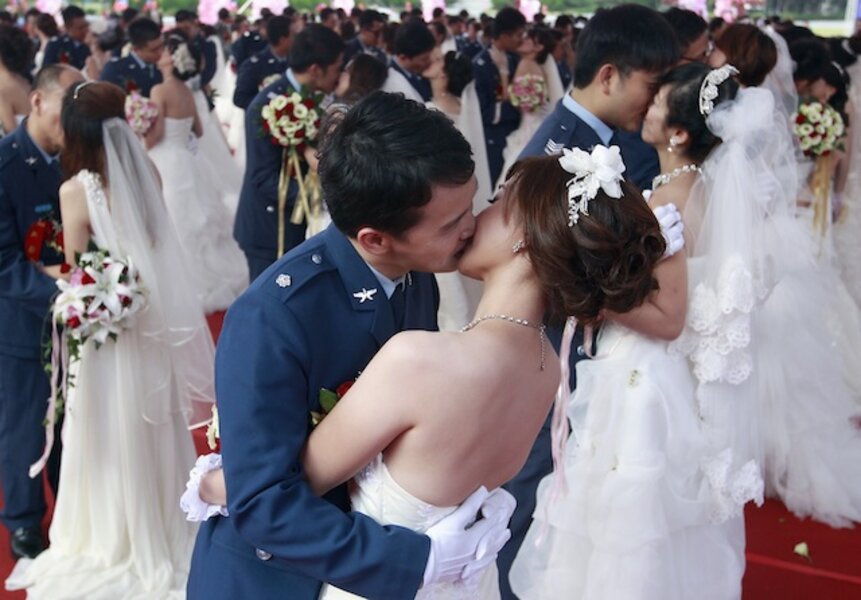Wedding tourism in Taiwan: lots of flash, little cash
Loading...
| Taipei, Taiwan
Henry Ho and his fiancée, Tracy Chang, recently spent five hours clicking through engagement photographs as their photographer fixed awkward spots, including one that made Mr. Ho look plumper than he liked.
Both are longtime residents of Brisbane, Australia. But when it came time to tie the knot, they headed out of town – far from friends, but in reach of some family members – more specifically, Taiwan.
“It went over our expectations,” Mr. Ho says at the downtown Taipei studio as Ms. Chang flips through photos on a flat-screen monitor. They say their wedding was cheaper and more lavish in Taipei, where their photographers let them borrow 10 outfits for use on the wedding day and a pre-wedding photo shoot. Best was the cost: Their bill for everything but the wedding day photos came to a little over $4,000, a cool 13 percent less than at home.
The couple are among thousands – 5,000 in 2012 – who visit Taiwan each year for weddings and wedding photo shoots. The wedding visitors – mostly ethnic Chinese who speak Mandarin – hail largely from mainland China, Hong Kong, Malaysia, and Singapore. But some, like Ho and Chang, travel from Australia and North America.
Taiwan's tourism bureau targeted the business six years ago, and has nudged its way to a regional wedding destination by offering quality services with lower prices. The scenery is a plus, too, with Taiwan’s high mountains and unfettered coastlines seen as prized backdrops for the perfect image. Good train or bus connections make it easy to move among scenic spots for photos.
Costs can easily mount up: to honor tradition, brides may change clothes several times on wedding day. They wear additional outfits, including fake hair, for photo shoots that will form several volumes for a prominent spot on the couple's bookshelves.
Ho and Chang realized they would need to buy those dresses, veils, and a tuxedo if they held their wedding in Australia. So in mid-April they visited Cinderella, a Taipei studio recommended by friends, for a full day of choosing outfits, including a yellow gown and a puffy purple outfit. Her fiancé went with a tuxedo for the major portraits and a jersey for less formal shots.
The next day, Cinderella arranged a ride to a five-acre wedding photo venue in the northwest coastal city of Danshui. There Ho and Chang lined up with other 20 other couples from various studios for a 12 hour photo shoot at a red brick church, a Dutch-style windmill, and the beach at sunset.
“The feeling is that photos taken overseas mostly look pretty serious,” says Ho, who works in a drink shop in Brisbane. He and Chang, a children’s educator, wanted a range of photos. “Here you get some that are quite elegant and others that make you look more active.”
The Tourism Bureau also organizes group weddings every October at the high-elevation, forested Alishan National Scenic Area.
Sixteen couples, including ones from overseas, are chosen every year based on engagement stories submitted in June. They get free two-day trips to Alishan for photos with a sturdy, 2,000-year-old Formosan red cypress tree, a symbol of a long-lasting marriage.
The growing market has pushed the total number of Taiwan wedding photo studios past 1,000 over six years, says Tai Sheng-he, chairman of the Taipei Wedding Photography Association. That’s too many, he says, because the foreign clientele has only held steady since 2012, possibly a result of growing interest in South Korea, where wedding tourism has spread to hotels and cruise ships, and wedding-related promotions in Thailand and the Philippines.
Kelvin Yueh, the photography director of Fashion Bridge studio, says about one foreign couple visits his shop every day in the popular months of March, April, September, and October.
Across the street and down the block, the Sophia wedding studio brings in clients by custom-making. Its Taiwan factory produces a new outfit every week, giving clients 1,000 to choose from, says store manager Hsu Pei-ching.






